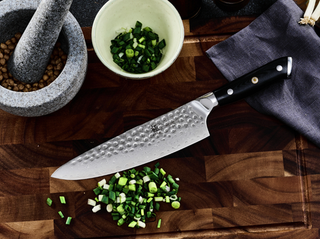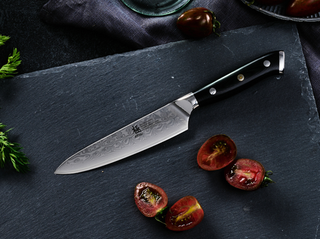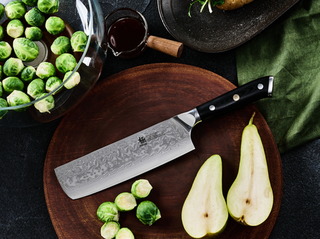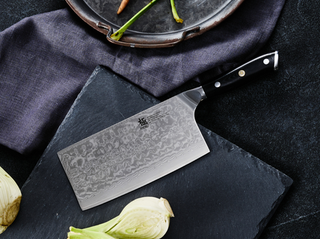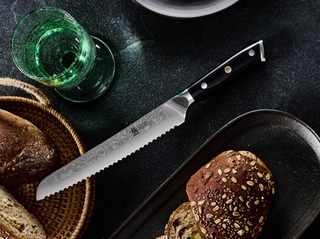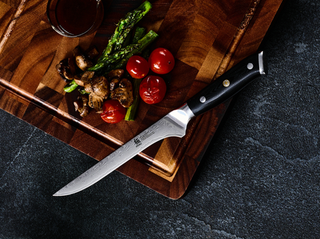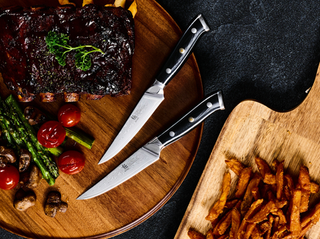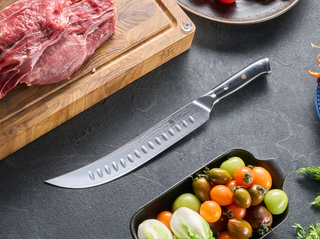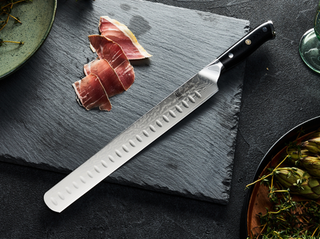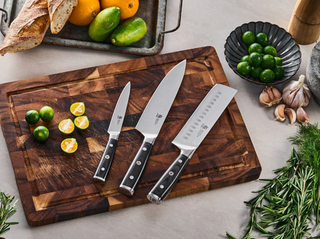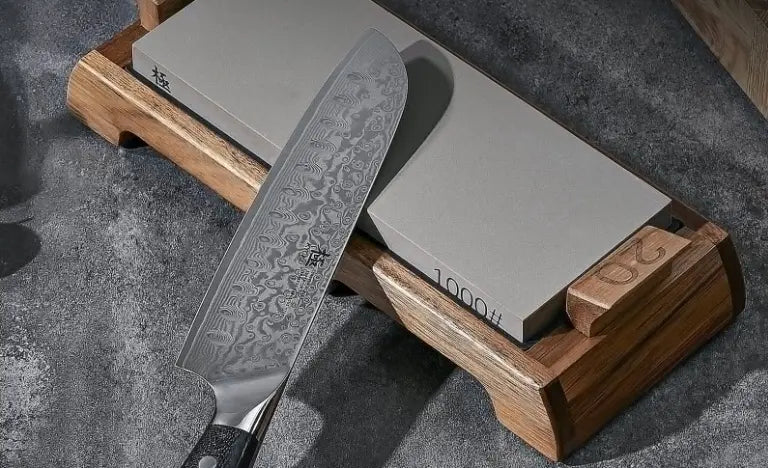A sharp knife is essential in the kitchen. Even high-quality blades dull over time, making how to sharpen a chef knife an important skill. This guide will take you through the process of breathing new life into your dull blades using a whetstone.

Purpose of This Article
Our goal is to equip you with the knowledge and skills to sharpen your chef knife using a whetstone. You'll learn why professionals prefer whetstones, how to choose the right one, and the step-by-step process to achieve a razor-sharp edge.
Key Points Covered
- The advantages of using whetstones for knife sharpening
- How to select the appropriate whetstone grit
- A detailed, step-by-step sharpening guide
- Maintenance tips for both your knives and whetstones
- Troubleshooting common sharpening issues
Let's explore whetstone sharpening and unlock your kitchen knives' potential.
1. Why Choose a Whetstone for Knife Sharpening?
Whetstones offer unmatched control and flexibility. Here's why they're the go-to choice for professionals:
- They work on all types of knives
- You can set precise angles for different blades
- They're cost-effective in the long run
These benefits make whetstones the top choice for serious knife care.
2. Choosing the Right Whetstone: What Grit to Sharpen Chef Knife?
Grit matters when it comes to whetstones. Here's a simple breakdown:
- 400-1000 grit: For repairing very dull or damaged knives
- 1000-3000 grit: For regular sharpening
- 4000-8000 grit: For fine polishing
Most home cooks find a 1000/6000 grit combination stone ideal, offering both sharpening and polishing in one tool.

3. Water vs. Oil, and Why Water Wins
|
Feature |
Oil Stones |
Water Stones |
|
Lubricant |
Oil |
Water |
|
Grit Range |
220 - 1000 |
200 - 8000 |
|
Speed of Sharpening |
Slower |
Faster |
|
Maintenance |
Low maintenance |
Requires soaking and flattening |
We recommend using water with your whetstone. Here's why:
- Less messy than oil
- Cuts faster, especially on harder steels
- Easier to clean up
The trade-off? Water stones need flattening more often. But for most home cooks, this isn't a frequent concern.
4. How to Sharpen Chef Knife: A Step-by-Step Guide
1. Safety First!
Before we start, remember:
- Always sharpen away from your body
- Use a non-slip surface
- Take your time - rushing leads to mistakes
2. What Angle to Sharpen Chef Knife?
Most chef knives need a 15-20 degree angle. Here's how to find it:
- Place the knife on the stone at roughly half the desired angle
- Slowly raise the spine until you feel the edge catch on the stone
3. The Sharpening Process
- Soak your whetstone for 10-15 minutes
- Start with the coarser grit
- Maintain your chosen angle and use light pressure
- Sweep the blade from heel to tip
- Repeat 10-15 times on each side
- Switch to the finer grit and repeat

4. Understanding the Burr
As you sharpen, you'll create a slight burr - a thin wire of metal on the edge. This means you've successfully sharpened to the edge. Feel for it gently with your thumb (carefully!), then remove it with light strokes on the fine grit side.
5. How Often to Sharpen Chef Knife?
It depends on use:
- Home cooks: Every 2-3 months
- Professional chefs: Weekly or bi-weekly
- When you notice decreased performance
Regular upkeep keeps knives sharp and ready for use.
6. Caring for Your Whetstone and Knives
Whetstone Maintenance
To keep your whetstone in prime condition:
- Clean after each use with water and a soft brush
- Store in a dry place to prevent cracking
- Flatten with a special flattening stone when it becomes uneven
Proper Knife Storage
After sharpening, store your knives properly:
- Use a magnetic strip or knife block
- Never store loose in a drawer
- Consider blade guards for added protection
Proper storage not only protects your newly sharpened edge but also ensures safety in your kitchen.
Kyoku's Top Picks for Sharpening Success
1. Kyoku Professional Whetstone Kit
- 1000/6000 grit combination
- Non-slip bamboo base included
- Perfect for beginners and pros alike
2. 8" Gyuto Chef Knives VG10 Damascus Steel
- Damascus steel
- Designed for optimal performance with whetstone sharpening
- Ergonomic handle for comfort during long prep sessions
These tools are designed to work together, providing you with the best possible sharpening experience.
7. Troubleshooting Common Sharpening Issues
Even experienced sharpeners encounter problems. Here's how to address common issues:
- Uneven edge: Often caused by inconsistent angle. Use an angle guide or practice maintaining a steady hand.
- Knife still dull after sharpening: You may not have formed a burr. Ensure you're reaching the edge on both sides.
- Scratches on the blade: You're likely using too coarse a grit. Start with a finer grit or use lighter pressure.
- Stone glazing over: This happens when metal particles clog the stone. Clean your stone regularly during use.
By addressing these common problems, you'll improve your sharpening skills and achieve better results.
8. Different Chef Knives, Different Needs
Not all chef knives are created equal. Here's how to approach different types:
- Western-style chef knives: Usually require a 20-degree angle per side
- Japanese Gyuto: Often sharpened at a more acute 15-degree angle
- Single-bevel knives like Yanagiba: Require a special technique, sharpening only one side
Always research your specific knife type before sharpening.
9. Testing Your Knives’ Sharpness
After sharpening your knives, how do you know if your knife is truly sharp? Try these tests:
- Paper test: A sharp knife should cleanly slice through a sheet of paper
- Tomato test: It should easily pierce the skin of a tomato without pressure
- Arm hair test (carefully!): A truly sharp edge will shave arm hair with minimal pressure
Remember, a truly sharp knife should cut with minimal pressure.
10. Whetstone vs. Other Sharpening Methods
While we advocate for whetstone sharpening, it's worth understanding how it compares to other methods:
|
Method |
Pros |
Cons |
|
Whetstone |
Precise control, works for all knives |
Requires skill and time |
|
Electric sharpeners |
Fast and easy |
Can remove too much metal, less precise |
|
Honing rod |
Quick touch-ups |
Doesn't actually sharpen, only realigns edge |
|
Professional service |
Expert results |
Expensive, not always convenient |
Whetstone sharpening offers the best balance of control, versatility, and cost-effectiveness for most users.
Final Thoughts: The Art of Knife Care
Remember, the journey to mastering how to sharpen a chef knife is ongoing. Each knife, each stone, and each sharpening session is an opportunity to learn and improve. Embrace the process, and soon you'll find that the few minutes spent sharpening become a meditative prelude to your cooking adventures.
So, are you ready to elevate your culinary experience? Grab your Kyoku whetstone and chef knife, and start your sharpening journey today. Your taste buds—and your precisely cut ingredients—will thank you!
